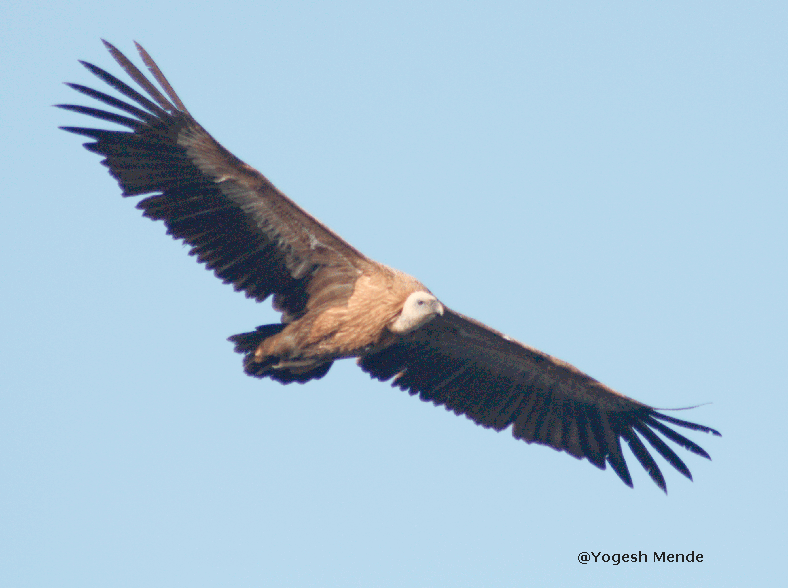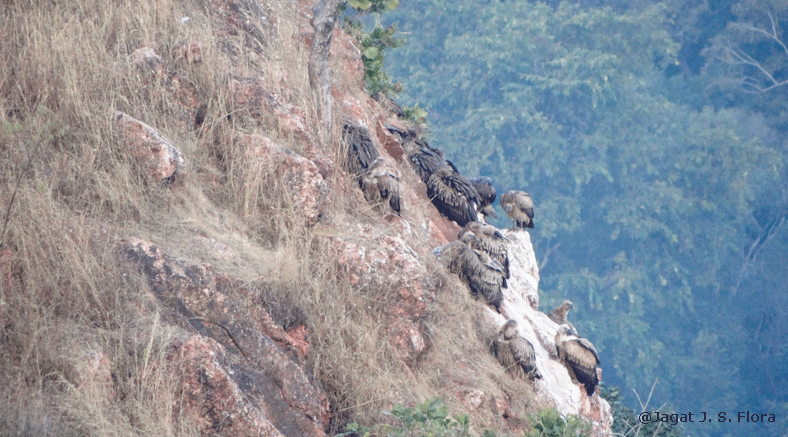Vulture Population Estimation-2013 Report
Introduction:
 Regular
Vulture Population Estimation at Panna Tiger Reserve (PTR) started in
2010. Within the PTR we had only local manpower to do it that is totally
untrained to perform a purely technical job. Then we trained our local
staff to identify in their own way and they counted the vultures as
Lal sir (Red Headed), Pila chonch (Yellow
Beaked) and Kali chonch (Black Beaked) vultures in 2010.
The survey was very crude. After doing this exercise the figures that
were arrived at were, more than 600 in 2010. This initial exercise gave
a glimpse of the vulture holding potential of Panna’s landscape. As such
Panna landscape is very suitable for vultures with so many gorges and
rock cliffs with ledges that can habit vultures in good numbers. Winters
added more migratory vultures to the existing numbers of residential
vultures. To assess the real vulture potential by arriving at right
numbers, park had to overcome the shortcoming of knowledgeable manpower
in good numbers. Any such exercise in the vast landscape needs a minimum
of 100 volunteers who know this business. Thus application of PPP
(Public People Participation) model of Vulture Population Estimation was
picked up. Therefore we planned a better estimation with the help of
better equipped knowledgeable birders outside the system. Thus from the
year 2010 Panna Management came out with the Idea of PPP model of
Vulture Population Estimation. In this model, Park invites volunteer’s
participation through advertisements. Participants should have basic
minimum knowledge of identifying the birds. They have to take up the
cost of coming to panna and back. Once the participants are at Panna
(after their selection) Park Management takes care of their stay in the
park during the period of vulture population estimation. Vulture
identification spots are identified before hand by the management.
Orientation and field identification camp gets conducted on the day of
arrival. Participants are sent to those spots in twos or threes, where
they have to spend 3-6 days counting the birds along with observing the
live nests and other vulture behavior. The data collected by the
volunteers is used to come up with reasonable figures of various vulture
species. Besides volunteers insitu tourist guides with PTR are
also participating in the process for last four years. Thus this model
is working very well at Panna Tiger Reserve.
Regular
Vulture Population Estimation at Panna Tiger Reserve (PTR) started in
2010. Within the PTR we had only local manpower to do it that is totally
untrained to perform a purely technical job. Then we trained our local
staff to identify in their own way and they counted the vultures as
Lal sir (Red Headed), Pila chonch (Yellow
Beaked) and Kali chonch (Black Beaked) vultures in 2010.
The survey was very crude. After doing this exercise the figures that
were arrived at were, more than 600 in 2010. This initial exercise gave
a glimpse of the vulture holding potential of Panna’s landscape. As such
Panna landscape is very suitable for vultures with so many gorges and
rock cliffs with ledges that can habit vultures in good numbers. Winters
added more migratory vultures to the existing numbers of residential
vultures. To assess the real vulture potential by arriving at right
numbers, park had to overcome the shortcoming of knowledgeable manpower
in good numbers. Any such exercise in the vast landscape needs a minimum
of 100 volunteers who know this business. Thus application of PPP
(Public People Participation) model of Vulture Population Estimation was
picked up. Therefore we planned a better estimation with the help of
better equipped knowledgeable birders outside the system. Thus from the
year 2010 Panna Management came out with the Idea of PPP model of
Vulture Population Estimation. In this model, Park invites volunteer’s
participation through advertisements. Participants should have basic
minimum knowledge of identifying the birds. They have to take up the
cost of coming to panna and back. Once the participants are at Panna
(after their selection) Park Management takes care of their stay in the
park during the period of vulture population estimation. Vulture
identification spots are identified before hand by the management.
Orientation and field identification camp gets conducted on the day of
arrival. Participants are sent to those spots in twos or threes, where
they have to spend 3-6 days counting the birds along with observing the
live nests and other vulture behavior. The data collected by the
volunteers is used to come up with reasonable figures of various vulture
species. Besides volunteers insitu tourist guides with PTR are
also participating in the process for last four years. Thus this model
is working very well at Panna Tiger Reserve.
Vulture Population Estimation 2013 Process:
 Over
last two years it was felt that over all three day period of vulture
count is not sufficient to get quality data. Some of the participants
were found to be new to birding. Even then the park wanted to encourage
the new comers. Hence the Vulture Population Estimation process was
divided into two phases. A better birding knowledge criterion was
applied in the selection of participants who participated during the
entire period. Participants with some lower level of birding ability
were selected for only Phase II. Through this process park management
tried out the phasing of the entire process. The process lasted for six
days for the Phase I and II participants where as it is three days for
only Phase II participants. This time in all 112 applications were
received from ten states of which 94 were selected after screening. Of
the selected 94, 42 applicants participated from seven states including
Andhra Pradesh, Karnataka, Madhya Pradesh, Haryana, Bihar, Maharashtra
and New Delhi. 16 guides were inducted into the process from the park
side. Thus total participation on the ground is 62 individuals. Total
sites considered this time for vulture population estimation is 42.
Temperatures shot up dramatically two days before the process and we
anticipate this change in climate is going to affect the outcome with
respect to numbers of migratory vultures.
Over
last two years it was felt that over all three day period of vulture
count is not sufficient to get quality data. Some of the participants
were found to be new to birding. Even then the park wanted to encourage
the new comers. Hence the Vulture Population Estimation process was
divided into two phases. A better birding knowledge criterion was
applied in the selection of participants who participated during the
entire period. Participants with some lower level of birding ability
were selected for only Phase II. Through this process park management
tried out the phasing of the entire process. The process lasted for six
days for the Phase I and II participants where as it is three days for
only Phase II participants. This time in all 112 applications were
received from ten states of which 94 were selected after screening. Of
the selected 94, 42 applicants participated from seven states including
Andhra Pradesh, Karnataka, Madhya Pradesh, Haryana, Bihar, Maharashtra
and New Delhi. 16 guides were inducted into the process from the park
side. Thus total participation on the ground is 62 individuals. Total
sites considered this time for vulture population estimation is 42.
Temperatures shot up dramatically two days before the process and we
anticipate this change in climate is going to affect the outcome with
respect to numbers of migratory vultures.
Out Come over the years:
-
Vulture Identification guide for the participants.
-
Bird Check lists prepared in 2004 identified just four species of vultures in the park viz., Read Headed Vulture, Egyptian Vulture, Long Billed and White Backed Vultures. All the four are residential to the landscape. Till then migratory vultures were neither identified nor listed from the park, even though they were actually arriving here during the winters in earlier times. Vulture Population Estimation 2010 added one Griffon Vultures (Himalayan) and Cinerous Vulture to the list. 2011 Vulture Population Estimation added Eurasian Griffon vulture to the already improved list by making Panna landscape one of the most important landscapes of vulture population. Now of the nine known vultures of Indian sub-continent seven can be seen at Panna Tiger Reserve during the winters.
-
The PPP model is proving a success where in Park management is getting the benefit of the knowledge from outside in the public domain. Simultaneously participants are getting the benefit of being part of the management during this period.
-
Excellent photo data bank of vultures (along with other birds) of Panna landscape contributed by the participants
-
Vulture Numbers Over the Years at Panna Tiger Reserve
|
S.No. |
Name of the Vulture Species |
Vulture Numbers |
||||||||
|
Maximum |
Minimum |
Mean |
||||||||
|
2011 |
2012 |
2013 |
2011 |
2012 |
2013 |
2011 |
2012 |
2013 |
||
|
|
Residential |
|
|
|
|
|
|
|
|
|
|
1 |
Long billed |
966 |
630 |
726 |
584 |
369 |
226 |
775 |
502 |
476 |
|
2 |
White backed |
127 |
235 |
146 |
70 |
148 |
25 |
99 |
213 |
86 |
|
3 |
Egyptian |
90 |
161 |
76 |
60 |
112 |
28 |
75 |
143 |
52 |
|
4 |
Red headed |
57 |
127 |
67 |
45 |
78 |
23 |
51 |
107 |
45 |
|
|
Total |
1240 |
1153 |
1015 |
759 |
707 |
302 |
1000 |
965 |
659 |
|
|
Migratory |
|
|
|
|
|
|
|
|
|
|
5 |
Eurasian Griffon |
44 |
379 |
64 |
29 |
186 |
18 |
37 |
309 |
41 |
|
6 |
Himalayan Griffon |
50 |
162 |
184 |
21 |
84 |
45 |
36 |
138 |
115 |
|
7 |
Cinerous |
6 |
1 |
06 |
5 |
1 |
01 |
6 |
1 |
04 |
|
|
Total |
100 |
542 |
254 |
55 |
271 |
64 |
79 |
448 |
160 |
|
|
Unidentified |
0 |
102 |
78 |
0 |
91 |
17 |
0 |
97 |
48 |
|
|
Grand Total |
1340 |
1797 |
1347 |
814 |
1069 |
383 |
1079 |
1510 |
867 |
Improvements this year:
-
Experimentation in phasing of the process to bring in quality improvement in the processes.
-
From this year onwards population dynamics of Vultures will be monitored. Vulture nesting sites are being given focus to identify and evaluate the breeding potential of various vultures in this landscape.
Further Plans:
-
Technical report of Vulture Population Estimation process by the end of Feb, 2013.
-
Peregrine Falcon which is a potential predator of vulture chicks will also be counted in the coming years.
-
Live nests will be counted for the second time in the April/May for finding the breeding success of the vultures in Panna landscape.
Concluding Function:
Formal concluding function of Vulture Population Estimation 2013 was organized at Hinauta between 1700-1830 hrs. Shri. S.K. Mandal, CCF, Chattarpur was Chairperson and Shri. Pankaj Shrivastav, IG Sagar was the chief guest of the function. After unveiling of memento were the participation certificates and memento were distributed to participants. All the participants hailed the process and wanted that the exercise need to be continued every year. Chief guest and Chairperson addressed the gathering. Shri. Anil Maheswari, SP Panna, Shri, Kindo, GM, NMDC, Shri, Lokendra Singh, EX MP and EX MLA, Panna and Shri, Hanumat Singh, Wildlife Advisory Board Member were present. Field Directot presented the report of the VUlture Population Estimation 2013.
|
Hinauta, 21.01.2013 |
(R.Sreenivasa
Murthy,) |